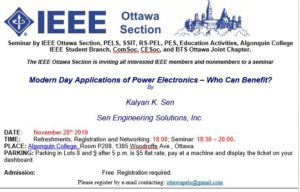Events
IEEE YP Ottawa Section: Introduction to Amateur Radio Certification
Introduction to Amateur Radio Certification
Presenters: Mike Kennedy and Anis Ben Arfi
This workshop covers the basics of Amateur Radio including:
- How to obtain your license
- Demonstrations
- Hands on!
- Ready to get on the air?
Date: Wednesday, November 27th, 2019 (5:00 – 7:00 PM)
Location: Carleton University, Tory Building Room: 230!
Snacks and refreshments provided!
For more information, visit the following:
https://events.vtools.ieee.org/m/210526
https://www.facebook.com/events/3009020362459225/
https://twitter.com/IEEEYPOttawa/status/1195910737136431106?s=20
https://site.ieee.org/ottawa-yp/event/workshop-introduction-to-amateur-radio-certification/

Seminar by IEEE Ottawa Section, PELS, SSIT, RS-PEL, PES, Education Activities, Algonquin College IEEE Student Branch, ComSoc, CESoc, and BTS Ottawa Joint Chapter.
The IEEE Ottawa Section is inviting all interested IEEE members and nonmembers to a seminar
Modern Day Applications of Power Electronics – Who Can Benefit?
ByÂ
Kalyan K. Sen
Sen Engineering Solutions, Inc.
DATE:
November 28th 2019
TIME:
Refreshments, Registration and Networking: 18:00;
Seminar: 18:30 – 20:00.
PLACE:
Algonquin College, Room P208, 1385 Woodroffe Ave., Ottawa.
PARKING:
Parking in Lots 8 and 9 after 5 p.m. is $5 flat rate, pay at a
machine and display the ticket on your dashboard.
ADMISSION:
Free. Registration required.
Please register by e-mail contacting: ottawapels@gmail.com
Abstract:
Application of power electronics is widespread in everyday life. Some applications are considered as “nice to have it;†in other cases, they are essential. This presentation discusses a wide variety of daily-used applications around the world. Also covered is an advanced topic, such as SMART Controller that today’s grid requires for voltage regulation, power factor regulation, unbalance voltage/current regulation, harmonic elimination and so on. A SMART Controller that is based on functional requirements and cost-effective solutions is derived from utilizing the best features of all the technical concepts that are developed until now. Final year students of electrical engineering undergraduate curriculum, post graduate students, researchers, academicians and utility engineers will benefit from attending this course. The participantswill hear from an expert who actually designed and commissioned a fewutility-grade SMART controllers since their inception in the 1990s.
Modern Day Applications of Power Electronics – Who Can Benefit
IEEE Photonics Society Distinguished Lecturer Program
Advanced semiconductor lasers:Ultra-low operating energy and heterogeneous integration with Si photonics devices
Shinji Matsuo, NTT Photonics Laboratories, Japan
Abstract: The electrical power consumed in data transmission systems is now hampering efforts to further increase the speed and capacity at various scales, ranging from data centers to microprocessors. Optical interconnects employing an ultralow energy directly modulated lasers will play a key role in reducing the power consumption. Since a laser’s operating energy is proportional to the size of its active volume, developing high-performance lasers with a small cavity is important. For this purpose, we have developed membrane DFB and photonic crystal (PhC) lasers, in which active regions are buried with InP layer. Thanks to the reduction of cavity size and the increase in optical confinement factor, we have achieved extremely small operating energy and demonstrated 4.4-fJ/bit operating energy by employing wavelength-scale PhC cavity. Reduction of the cost is also important issue because huge number of transmitters are required for short distance optical links. For this purpose, Si photonics technology is expected to be a potential solution because it can provide large-scale phonic integrated circuits (PICs), which can reduce the assembly cost compared with transmitters constructed by discrete devices. Therefore, heterogeneous integration of III-V compound semiconductors and Si has attracted much attention. For fabricating these devices, we have developed wafer-scale fabrication procedure that employs regrowth of III-V compound semiconductors on directly bonded thin InP template on SiO2/Si substrate. A key to realize high-quality epitaxial layer is total thickness, which must be below the critical thickness, typically 430 nm. Thus, membrane structure is quite suitable for heterogeneous integration. I will talk about our recent progress, focusing on ultralow-powerconsumption directly modulated lasers and their photonic integrated circuit. I will also describe progress in heterogeneous integration of these lasers and Si photonics devices.
Bio: Dr. Matsuo received a B.E. and M.E. degrees in electrical engineering from Hiroshima University, Hiroshima, Japan, in 1986 and 1988, and the Ph.D. degree in electronics and applied physics from Tokyo Institute of Technology, Tokyo, Japan, in 2008. In 1988, he joined NTT Optoelectronics Laboratories, Atsugi, where he was engaged in research on photonic functional devices using MQW-pin modulators and VCSELs. In 1997, he researched optical networks using WDM technologies at NTT Network Innovation Laboratories, Yokosuka. Since 2000, he has been researching InP-based photonic integrated circuits including fast tunable lasers and photonic crystal lasers at NTT Photonics Laboratories, Atsugi. Dr. Matsuo is a member of the IEEE Photonics Society, Japan Society of Applied Physics and the Institute of Electronics, Information and Communication Engineers (IEICE) of Japan.
Schedule:
- Meeting 6:30 PM to 9:30 PM
- Networking, Food & Refreshments, Work etc. – 6:00 PM to 6:30 PM, 9:30 PM to 10:00 PM
The IEEE Ottawa Section meetings consists of:
- Call To Order and Introduction
- Acceptance of the Agenda of the Meeting
- Acceptance of the Previous Meeting Minutes
- Scheduled New Business
- Officer Reports
- Student Reports
- Chapter Reports
- Conferences
- Affinity Group Reports
- Committee Reports
If you are interested in presenting to the Section, please email our secretary: Abdulhak Nagy (abdulhak.nagy@carleton.ca)

Joing IEEE WIE Ottawa in attending Male Allyship in STEM Panel Discussion. The panel will include a complimentary lunch for a discussion of the roles and
responsibilities men can have in creating a positive and sustainable
impact in support of women in science and engineering, including
conversations about:
- The allyship continuum, from apathy to advocacy
- Challenges with allyship
- Examples of how men can support women in science and engineering
For more information, please visit: https://carleton.ca/engineering-design/cu-events/male-allyship-in-stem-a-panel-discussion/

